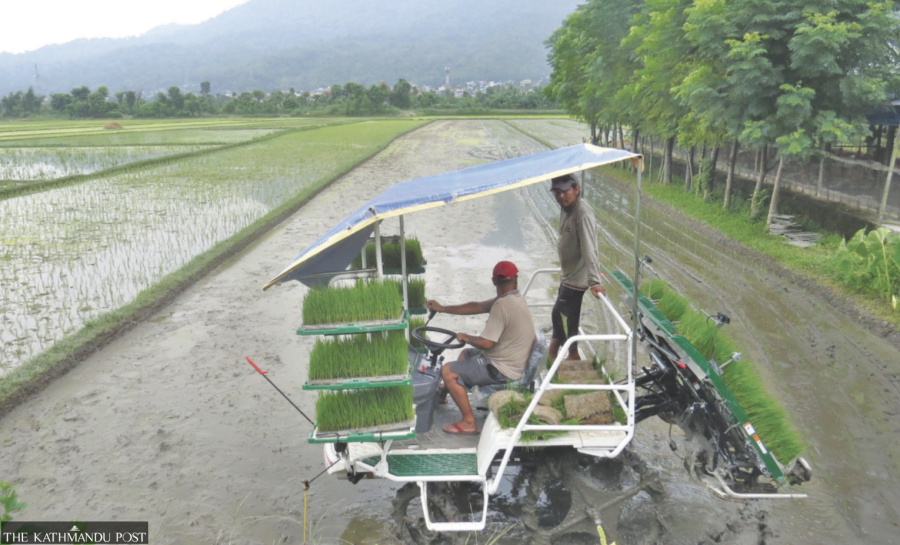Money
Chitwan staring at crisis as paddy fields vanish fast
The district south of Kathmandu has seen farmers switch to cash crops like bananas and fisheries as labour-intensive paddy brings lower return.
Ramesh Kumar Paudel
Gopi Man Shrestha and his family migrated to Chitwan from Lamjung in 1970. The pull factor was fertile land and irrigation facilities in the plains.
The Shresthas purchased two bighas of land in Ameliya, Madi. Paddy yield was high due to the soil rich in nutrients and easy availability of irrigation. The family was also able to sell the grains after storing the year’s need for consumption.
“I purchased two more bighas,” Shrestha said.
Hundreds of families, particularly those in the hills, migrated to Chitwan in the 1970s and 1980s, in search of fertile lands.
However, the situation is different now. Shrestha still owns land in Ameliya, but does not cultivate it.
Locals are leaving the villages of Ameliya, adjoining the Chitwan National Park, Nepal’s first wildlife sanctuary.
As the village gradually began emptying, paddy transplantation has also stopped.
“Now, we buy rice to eat,” Shrestha said.
Purnamaya Adhikari of Jiwanpur, Khaireni Municipality Ward 10, has been growing paddy on a bigha and a half.
She has not switched to other crops but has seen banana plants grow on her neighbours' fields.
“Many farmers have switched to banana. Paddy is least preferred,” Adhikari said.
Chitwan has seen farmers switching to cash crops as the income from paddy is low.
Statistics at the Agriculture Development Office, Chitwan show that paddy plantation area is shrinking fast.
In the key season, the monsoon, farmers produce paddy on 22,000 hectares, down from 31,000 hectares two decades ago.
The office record shows that paddy production peaked in 2002–03 when the Maoist insurgency compelled people to rush to the Tarai.
Indra Dhungana, chief of the Project Implementation Unit, Bharatpur, under the Prime Minister Agriculture Modernisation Project, said there are no specific studies, but paddy cultivation in Chitwan is declining. “It’s because Chitwan has grown into a residential area, with land being plotted for housing.”
The paddy fields in Chitwan have been filled with concrete houses in just 20 years. Besides, farmers have started searching for alternative sources of income.
As commercial banana and vegetable farming and fisheries expand, paddy fields are vanishing, Dhungana said.
Umraj Aryal, an official at the Agriculture Development Office, Chitwan, said the commercial vegetable farming trend is steady. “Nowadays, capsicum farming is growing in east Chitwan,” he said. “As the capsicum is sowed in early September, transplanting paddy [in the summer] is impossible.”
Residential area has increased in Bharatpur wards 11 and 12.
Around 20 years ago, those areas mostly remained filled with paddy, Aryal said.
The Padampur area inside the national park, known for high paddy yield, has been shifted to Barandabhar forest south of the highway. In the new Padampur, banana and vegetable farming is thriving.
Satya Narayan Chaudhary of Ratnanagar, Bichauli, does not believe that the paddy acreage has declined. “People have stopped farming.”
As farmhands are not readily available, there has been a growing use of machines, he said.
“Farmers are switching to other crops,” he said, admitting that land development for housing has increased. “It’s a serious issue.”
According to statistics, vegetable farming and fisheries in Chitwan covered 2,132 hectares and 68 hectares during 1998-99.
Vegetable farming has currently expanded to 6,503 hectares. However, since vegetable farming depends on the cropping cycle, it does not create a huge gap in the paddy production area, Chaudhary said.
Paddy transplantation, however, cannot be done in fields used for commercial Banana farming and fisheries.
Banana fields in Chitwan cover 2,200 hectares, while fish ponds have expanded to 800 hectares.
“With the decline in paddy production, hay output has also fallen. Straw is a huge source of animal feed. Along with rice, Chitwan now imports straw too,” said Jhalak Nath Kandel, chief of the Agriculture Development Office.
He said that the rice deficit in Nepal currently stands at 581,505 tonnes.
“It’s a serious issue if paddy plantation areas decline. The country’s food import bill has ballooned.”
Summer production has declined by a fourth, but there has been some growth in spring paddy areas and output.
In the fiscal year 2002-23, spring paddy was transplanted on 3,750 hectares, which increased to 5,540 hectares in 2022-23. This fiscal year, spring paddy is growing on 7,000 hectares.
“Demand for spring paddy is rising. A kind of cash crop, its farming is increasing,” said Nirmal Poudel, an agri economist at the Agriculture Development Office, Chitwan.
Agriculture technicians say spring paddy is less prone to diseases. As it is produced in a season with little rainfall, it is largely unaffected by pests. This pushes the yield up.
The summer paddy productivity stands at 4.4 tonnes per hectare while spring paddy output is 5.6 tonnes.
According to Dhungana, farmers harvested 6.4 tonnes of spring paddy a hectare this spring.
Due to farm mechanisation and improved irrigation, summer paddy also sees better harvest now.




 6.1°C Kathmandu
6.1°C Kathmandu1.jpg)















